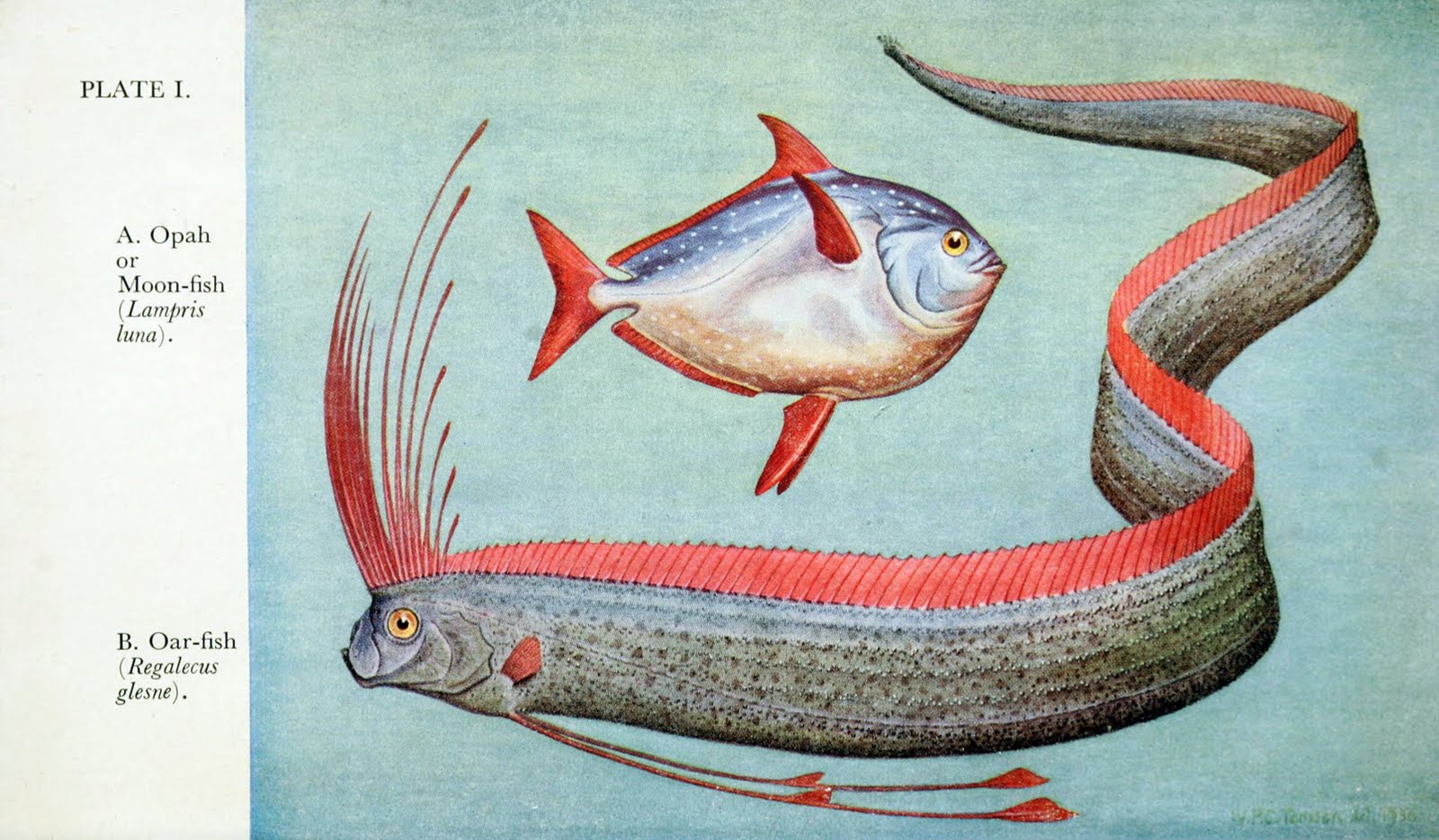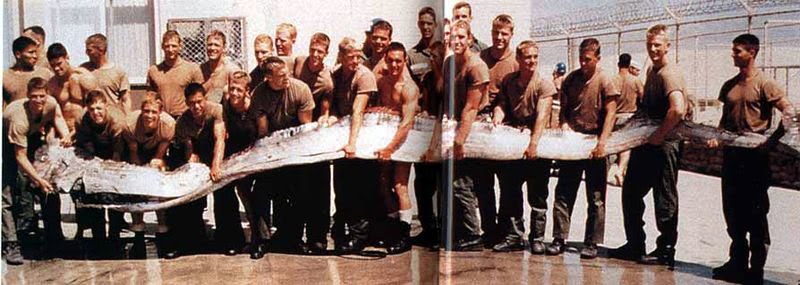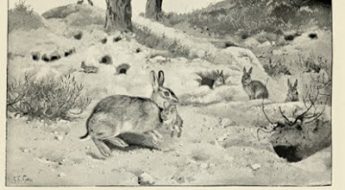Book of the Week: Living Sea Mammoths of Myth and Legend
This week, while browsing our Flickr site (which, by the way, has over 15,900 images!), we stumbled across the book Field Book of Giant Fishes (1949), by J.R. Norman and F.C. Fraser, and were intrigued. What exactly was a giant fish by this book’s standards, and what would we find when we delved into the pages of this enigmatic title?
To our delight, we found some surprising species featured within this volume. Species that make you think, “Maybe we aren’t too far off from the dinosaurs.” Some even include creatures that might be responsible for many of the “sea monster” claims sailors have made over the years. Plus, as is always a bonus for us, the descriptions were accompanied by lovely illustrations (by W.P.C. Tenison) of the mighty fish that call our oceans home today. We thought this title offered a great opportunity to showcase some of these aquatic marvels. So, without further ado…
 1) Giant Oar-Fish, also known as the King of Herrings. This critter is the world’s longest bony fish, reaching up to at least 11 meters (unconfirmed reports of 17 meters exist!) and weighing upwards of 300 kg! Living 300-1000 meters below the ocean’s surface, it is a rarely-seen deep sea wonder. Nevertheless, many scientists believe that this colossal beast may be responsible for many of the strange sea monster sightings reported throughout the years.
1) Giant Oar-Fish, also known as the King of Herrings. This critter is the world’s longest bony fish, reaching up to at least 11 meters (unconfirmed reports of 17 meters exist!) and weighing upwards of 300 kg! Living 300-1000 meters below the ocean’s surface, it is a rarely-seen deep sea wonder. Nevertheless, many scientists believe that this colossal beast may be responsible for many of the strange sea monster sightings reported throughout the years.
Despite the scarcity of sightings, there are several documented encounters with this species:
- On Dec. 10, 2010, a live specimen measuring 4 meters was caught off the Sinaloan coast of Mexico. One of the fisherman who caught it cautioned that “it might be the devil” and “feared it might swallow them.”
- On April 6, 2011, a 3.5 meter Giant Oar-Fish was found off of the east coast of Taiwan. It is believed that the creature surfaced as a result of the tsunami that hit Japan in March. Thus, it was given the nickname “Earthquake Fish.”
- And finally, in 1996, a 7-meter specimen was caught off of the coast of California. Pictured below is a team of Navy SEALs displaying the beast. (Image from pg. 20, All Hands)
 2) Blue Whale. So, everyone’s familiar with the Blue Whale – the largest animal on the face of the planet, and, for that matter, the largest animal known to have ever existed. (Take that, Dinosaurs!). At 30 meters long and 180 metrics tons, this creature is truly a behemoth. However, despite its size, the Blue Whale’s diet consists completely of small crustaceans called krill.
2) Blue Whale. So, everyone’s familiar with the Blue Whale – the largest animal on the face of the planet, and, for that matter, the largest animal known to have ever existed. (Take that, Dinosaurs!). At 30 meters long and 180 metrics tons, this creature is truly a behemoth. However, despite its size, the Blue Whale’s diet consists completely of small crustaceans called krill.
Some very interesting facts about the Blue Whale:
- It’s tongue weighs as much as an elephant (which, incidentally, is the largest living land mammal)
- When fully expanded, a Blue Whale’s mouth is large enough to hold 90 metrics tons of food and water
- Despite this large mouth, the Whale’s throat is so small that it cannot swallow anything larger than a beach ball
- At birth, Blue Whales weigh 6,000 lbs – the weight of a full-grown hippopotamus – and drink an average of 100 gallons of milk every day
- Blue Whale calves gain as much as 200 lbs every day
- A Blue Whale’s Heart weighs 1,300 lbs.
 3) Narwhal. Although not a mammoth in proportions, this sea critter nevertheless has many links to mythological associations. For obvious reasons, it is known as the “sea unicorn,” and Medieval Europeans believed that these “unicorn” horns possessed magical powers, such as the ability to cure poison and melancholia. The Inuit people believe the Narwhal tusk came about when “a women with a harpoon rope tied around her waist was dragged into the ocean after the harpoon had struck a large narwhal. She was transformed into a Narwhal herself, and her hair, which she was wearing in a twisted knot, became the characteristic spiral Narwhal tusk.”
3) Narwhal. Although not a mammoth in proportions, this sea critter nevertheless has many links to mythological associations. For obvious reasons, it is known as the “sea unicorn,” and Medieval Europeans believed that these “unicorn” horns possessed magical powers, such as the ability to cure poison and melancholia. The Inuit people believe the Narwhal tusk came about when “a women with a harpoon rope tied around her waist was dragged into the ocean after the harpoon had struck a large narwhal. She was transformed into a Narwhal herself, and her hair, which she was wearing in a twisted knot, became the characteristic spiral Narwhal tusk.”
- The Narwhal is most closely related to the Beluga Whale, and together they make up the only two living species of the Monodontidae family
- Narwhals are a strictly Arctic species, and rarely venture below 65 degrees North latitude
- The Narwhal’s name comes from the Old Norse word “nár,” which means “corpse.” It was given this name due to its grayish pigmentation, which gave it the appearance of a drowned sailor.
- A male Narwhal’s tusk can grow as long as 3 meters and weigh up to 22 lbs. About 1 in 500 male Narwhals grows a second tusk.
- In the 16th century, Queen Elizabeth was given a carved and bejeweled Narwhal tusk worth £10,000 – the cost of, in those times, an entire castle!
- The Narwhal is one of two possible explanations for the “giant sea phenomenon” described by Jules Verne in Twenty Thousand Leagues Under the Sea. (The other possibility? A man-made vessel. We like the Narwhal option better!)
We hope you’ve enjoyed these fun facts about some surprising creatures from the sea. Don’t forget that these are only a few of the animals pictured in our book of the week, Field Book of Giant Fishes (1949), by J.R. Norman and F.C. Fraser. The color illustrations from this book can be found on our Flickr site, but there are also dozens of smaller, ink drawings within the actual text, so be sure to check out the book in BHL as well!And remember, it might not be the age of the dinosaurs, but we’ve still got some mammoths living among us!






Whoops! Thanks for pointing out our typo! Yes, the Blue Whale is 30 meters, not 300. (What a fish that would be!) The post has been corrected. Sorry for the error!
A Blue Whale of 300 meters (?), must be difficult for this animal to navigate!